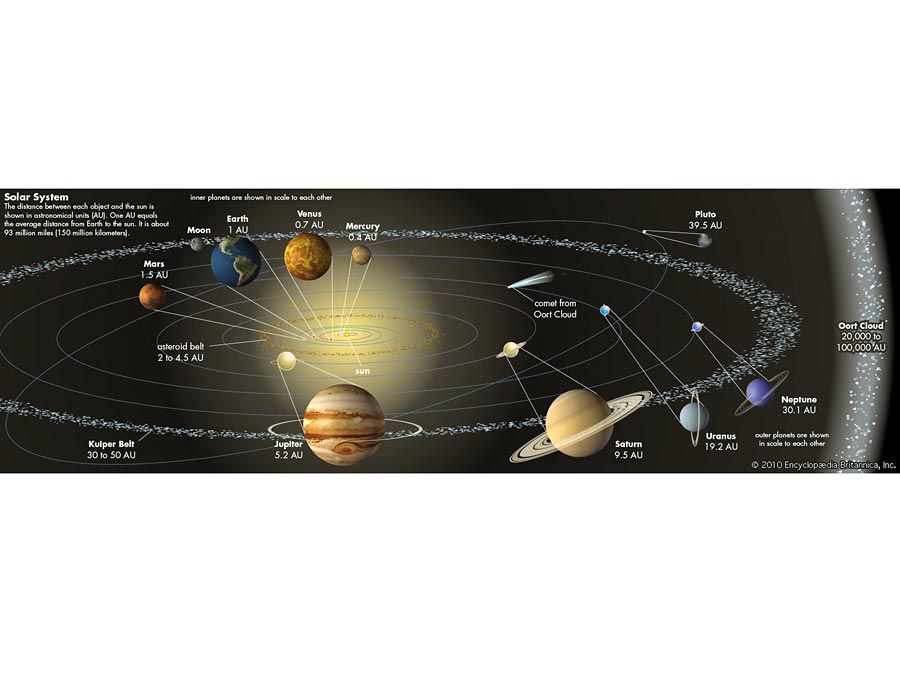astronomical unit
- Related Topics:
- astronomy
- universe
- solar parallax
astronomical unit (AU, or au), a unit of length effectively equal to the average, or mean, distance between Earth and the Sun, defined as 149,597,870.7 km (92,955,807.3 miles). Alternately, it can be considered the length of the semimajor axis—i.e., the length of half of the maximum diameter—of Earth’s elliptical orbit around the Sun. The astronomical unit provides a convenient way to express and relate distances of objects in the solar system and to carry out various astronomical calculations. For example, stating that the planet Jupiter is 5.2 AU (5.2 Earth distances) from the Sun and that Pluto is nearly 40 AU gives ready comparisons of the distances of all three bodies.
In principle, the easiest way to determine the value of the astronomical unit would have been to measure the Earth-Sun distance directly by means of the parallax method. In this approach, two observers stationed at the ends of a long, accurately known baseline—ideally, a baseline as long as Earth’s diameter—would simultaneously record the position of the Sun against the essentially motionless background of the distant stars. Comparison of the observations would reveal an apparent shift, or angular (parallax) displacement, of the Sun against the remote stars. A simple trigonometric relationship incorporating this angular value and the baseline length then could be used to find the Earth-Sun distance. In practice, however, the method cannot be applied, because the Sun’s intense glare blots out the background stars needed for the parallax measurement.
By the 17th century astronomers understood the geometry of the solar system and the motion of the planets well enough to develop a proportional model of objects in orbit around the Sun, a model that was independent of a particular scale. To establish the scale for all orbits and to determine the astronomical unit, all that was needed was an accurate measurement of the distance between any two objects at a given instant. In 1672 the Italian-born French astronomer Gian Domenico Cassini made a reasonably close estimate of the astronomical unit based on a determination of the parallax displacement of the planet Mars—and thus its distance to Earth. Later efforts made use of widely separated observations of the transit of Venus across the Sun’s disk to measure the distance between Venus and Earth.

In 1932 determination of the parallax displacement of the asteroid Eros as it made a close approach to Earth yielded what was at the time a very precise value for the astronomical unit. Astronomers then further refined their knowledge of the dimensions of the solar system and the value of the astronomical unit through a combination of radar ranging of Mercury, Venus, and Mars; laser ranging of the Moon (making use of light reflectors left on the lunar surface by Apollo astronauts); and timing of signals returned from spacecraft as they orbit or make close passes of objects in the solar system.
In 1976 the International Astronomical Union (IAU) defined the astronomical unit as the distance from the Sun at which a massless particle in a circular orbit would have a period of one year. This definition relied on a solely Newtonian model of the solar system. However, such a definition proved difficult to implement in general relativity, in which different values of the astronomical unit were obtained depending on an observer’s frame of reference. Through Kepler’s third law of planetary motion, the 1976 definition also depended on the mass of the Sun, which is always decreasing because the Sun shines through converting mass into energy. Increasing precision in measurements of the Sun’s mass meant that the astronomical unit would eventually become a time-varying unit. Because of these problems and because distances in the solar system were known so accurately that the astronomical unit was no longer needed to provide a relative scale, in 2012 the IAU fixed the astronomical unit at 149,597,870.7 km.
















